Dinghy Outboards & Dealing with Ethanol - Turn, Filter, Prevent
By Tom Hale
It is spring, your boat work list is long, and your launch date is approaching. There is a rush to get the boat back into her slip and ready to go. With the press of all the major spring boat projects, the dinghy does not have to be commissioned before launch and is not high on the list. You can recommission it once the boat is back in the water. Commissioning the outboard becomes a procedure which is only started the first nice day you are anchored somewhere and want to go ashore. Now when your neglected dinghy engine won’t start the eyes of the family are upon you, and your afternoon is shot.
Neglecting any boat equipment is likely to lead problems and dinghy engines live a life of neglect. Eventually the dinghy is going to pay you back. The most common outboard problems are fuel related. There are three procedures you can follow to minimize the fuel problems which plague small carbureted outboards of infrequent use. Turn, Filter and Prevent.
What causes fuel related problems? Ethanol. We have been living with ethanol fuel for more two decades. The dire predictions of catastrophic failures may not have materialized, but ethanol can cause its share of problems.
- The first issue is that the alcohol acts as a solvent and cleans out the fuel lines and carburetor passages which had developed a coating of gum and varnish through years of burning non-ethanol fuel. Worse, it can attack and break down the lining of the fuel hose. In either scenario, this material gets loose in the fuel supply and will eventually lodge in some small orifice such as a carburetor fuel jet.
- The second issue is that ethanol is hydroscopic: It absorbs moisture. The dry gas products we used for years were nothing more than ethanol which we added to our fuel tank to absorb any moisture and move it through the carburetor to be burned. Up to a point this can be beneficial. In a small boat with a vented fuel tank, spray, rain, and heavy morning dew contribute a lot of water to the fuel, the beneficial effect of the alcohol will be overwhelmed. A gallon of ethanol fuel can absorb 3 ounces of water before it separates. Once it separates the water alcohol component is highly corrosive and can damage metal components, in particular in the carburetor. (picture #1)
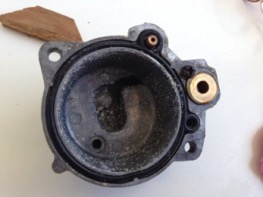
What are symptoms? Usually the first operational symptom of bad fuel, is rough idle. This rapidly progresses to no idle. The engine will run OK at speed but when you slow the throttle the engine dies. There are two fuel jets in the carburetor. The main jet disperses fuel when the engine is at speed, the much smaller idle jet delivers fuel when the engine is at idle. Debris plugs the idle jet first, and it plugs very easily. The engine will run on the main jet, but once it is slowed to idle speed the engine dies from fuel starvation.
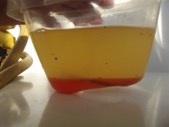
So what does problem fuel look like? This is the contents drained from a fuel tilter. The cloudy yellow component is gasoline with phase separated water/alcohol blend in suspension. The red liquid is the water/alcohol mix which has separated from the fuel. The alcohol water blend may be clear, yellow or rusty red; it depends upon what contaminants it contains. In this case the red color is rust from the inside of the fuel filter. (picture #2)
What can you do about it?
Turn the fuel. The first step towards a trouble free season with your dinghy outboard is to get rid of all the old fuel. Whether or not it is ethanol free, if it has been sitting around for 2 months, even if stabilized, it is past its prime. Take it home and burn it up in your yard equipment. If it causes a problem there you can walk into the house and get a cold drink. If it causes a problem out on the water you might be looking at a long row back to get a cold one.
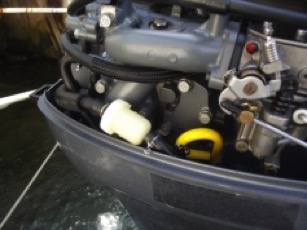
Filtration - An external fuel filter will give you advanced warning the fuel is going bad. At first it will appear to be cloudy. But you have to be able to see the fuel. Your outboard has an inline filter under the cowling. This filter does not give adequate protection for a couple of reasons. First of all, it is not a fine enough filter. Every outboard I have seen exhibiting ethanol fuel problems had an inline OEM filter. (picture #3) Secondly it is both translucent (but not transparent) and it is out of sight so you cannot observe what is going on in your system. It is necessary to have a filter with a transparent bowl to see the fuel problems developing.
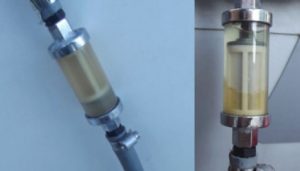
This is a filter I used for years, and it readily shows the debris in the fuel. In filter #4, the flow of fuel is moving quickly enough to keep the phase separated fuel in suspension and flowing into your carburetor. This common filter is the best of the inline filters I have seen. I recommend this filter because the clear glass makes it easy to see problems as soon as they start (West Marine Clear View fuel filter). (#3) This is the inside of a carburetor bowl after just 24 hours with phase separated fuel sitting in it. The white flecks are zinc oxide corrosion. For you have adequate time to notice and address the separated fuel before it gets to the carburetor it may necessary to have an even larger filter (picture #5) A full size transom mounted filter has enough internal volume that you can see the fuel becoming cloudy before it starts to affect the engine. The fuel moves slowly enough through the filter that the heavier, phase separated, component can settle out while the engine is running. This makes it quite easy to see a problem developing before it affects the engine.
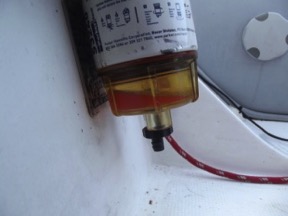
Prevention –
- Fuel refiners and fuel blenders say that ethanol fuel has a shelf life of 30 days. Using fuel stabilizers can extend the shelf life but they cannot stop phase separation. For a trouble free season, the best plan is to keep the fuel fresh: turn the fuel over regularly. For a reliable outboard this means get rid of your 6-gallon tank and use a 3-gallon tank so you are buying fresh fuel more frequently. Use you dinghy more often this year and try to burn up that 3 gallons of fuel each month. Run the carburetor dry at the end of the weekend or any time the engine is not going to be used for a week or more. The easiest way is to shut the fuel valve or disconnect the fuel hose while the engine is running at a fast idle.
- Keep water out of your tank. Close the tank vent when not in use…but we often forget . When you are running in rain and spray the vent must be open: water gets in. A fitted tank cover adds an additional level of protection.
Once an ethanol problem starts, it is likely to dog you for a while. The best defense is a good offense: get rid of old gas. Many marinas sell non ethanol fuel. It is worth your time and money to find and buy non-ethanol gasoline. Sure it might cost a few dollars more to fill your portable tank, but a carburetor cleaning at the outboard shop is $100. Do the math. Install a good filter. That can warn you in advance of a fuel problem. Have fun; use your dinghy and explore. Remember TFP, and here’s to a great trouble free summer on the water.


